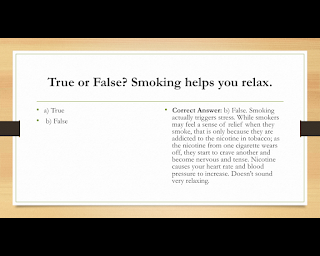Project by Sanghoon Lee & Suk Won Na
What was the issue of the project? Motivation?
Our project was designed to focus on the issue of smoking.
According to cancer research UK, more than 19% of adults are current smokers and
smoking is considered as a cause of several cancers including lung, larynx,
oesophagus, oral cavity and pharynx among other diseases.
In addition, Second-hand smoke causes an estimated 11,000 or more deaths
in the UK every year.
We decided to change the attitudes of smokers in the University of Warwick
and encourage them to quit smoking.
How did we design our project?
There are countless campaigns around the world which aim to persuade people to quit smoking. Most of them make an attempt to do so by raising awareness of harmful effects
of smoking by showing visual imagery of individuals who are suffering from
smoking-related diseases (Petty et al, 2003). This is rather ineffective, as fear appeals are likely to be denied (Ditto et al., 2003). So instead of presenting shocking images, we decided to create a
quiz.
Here is the procedure of our project:
1. We went to the central campus of Univeristy of Warwick and
asked smokers participate in our project.
2. If the smokers agreed to participate after a brief
explanation about what we are going to do, we gave them a quiz composed of 15 questions regarding smoking.
3. If the participant answered all of the questions correctly, we gave them a
reward (Lollipop).
4. If the participants got at least one question wrong, we asked them to place a
cigarette into a bin as a punishment, and also gave them a lollipop.
5. We gave advice to all of the participants after the quiz about the
alternatives of smoking.
The Quiz
The Quiz
Techniques that we used...
1) Cognitive dissonance: Cognitive dissonance occurred between the joy and smoking and the strive for a healthy lifestyle. To reach harmony, smokers decided that the joy of smoking is more important to them. We fought this conclusion by creating another dissonance, the will towards possession of a cigarette and the act of throwing it away, hoping that smokers will reach the conclusion that they did not want that cigarette anyway. This new conclusion challenged the initial belief.
2) Foot-in-the-door: Participants were first asked to answer a quiz, then if they got at least one question wrong, they were asked to throw away one of their cigarettes, a request which would usually be denied. The compliance rate was 100%.
References
Ditto, P. H., Munro, G. D., Apanovitch, A. M., Scepansky, J. A., & Lockhart, L. K. (2003). Spontaneous skepticism: The interplay of motivation and expectation in responses to favorable and unfavorable medical diagnoses. Personality and Social Psychology Bulletin, 29, 1120-1132.
Petty, R. E., Fabrigar, L. R., & Wegener, D. T. (2003). Emotional factors in attitudes and persuasion. Handbook of affective sciences, 752-772.

















No comments:
Post a Comment
Note: Only a member of this blog may post a comment.